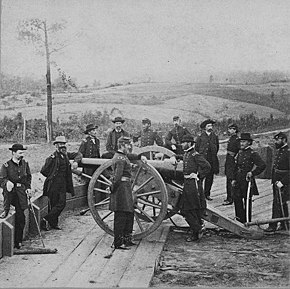
Back حملة أتلانتا Arabic آتلانتا کمپینی AZB Campanya d'Atlanta Catalan Atlanta-kampagnen Danish Atlanta-Feldzug German Campaña de Atlanta Spanish کمپین آتلانتا Persian Campagne d'Atlanta French Campagna di Atlanta Italian アトランタ方面作戦 Japanese
| Atlanta Campaign | |||||||
|---|---|---|---|---|---|---|---|
| Part of the American Civil War | |||||||
 Union Maj. Gen. William T. Sherman and his staff in the trenches outside of Atlanta | |||||||
| |||||||
| Belligerents | |||||||
|
|
| ||||||
| Commanders and leaders | |||||||
|
|
| ||||||
| Units involved | |||||||
| Army of Tennessee[2] | |||||||
| Strength | |||||||
| 112,819[3] | Beginning – 60,000 Infantry, 11,000 cavalry, 7,000 Artillery[4] | ||||||
| Casualties and losses | |||||||
|
31,687; (4,423 killed, 22,822 wounded, 4,442 missing/captured) |
34,979; (3,044 killed, 18,952 wounded, 12,983 missing/captured) | ||||||
The Atlanta campaign was a series of battles fought in the Western Theater of the American Civil War throughout northwest Georgia and the area around Atlanta during the summer of 1864. Union Maj. Gen. William Tecumseh Sherman invaded Georgia from the vicinity of Chattanooga, Tennessee, beginning in May 1864, opposed by the Confederate general Joseph E. Johnston.
Johnston's Army of Tennessee withdrew toward Atlanta in the face of successive flanking maneuvers by Sherman's group of armies. In July, the Confederate president, Jefferson Davis, replaced Johnston with the more aggressive General John Bell Hood, who began challenging the Union Army in a series of costly frontal assaults. Hood's army was eventually besieged in Atlanta and the city fell on September 2, setting the stage for Sherman's March to the Sea and hastening the end of the war.
- ^ Further information: Official Records, Series I, Volume XXXVIII, Part 1, pp. 89–114
- ^ Further information: Official Records, Series I, Volume XXXVIII, Part 3, pp. 638–675
- ^ Effective strength of the army under Maj. Gen. W. T. Sherman, during the campaign against Atlanta, Ga., 1864: Official Records, Series I, Volume XXXVIII, Part 1, pp. 115–117
- ^ Strength of the confederate forces: Official Records, Series I, Volume XXXVIII, Part 3, pp. 675–683